|
|
 |
|
 |
|
Mirjana Kos-Nalis ETHNOGRAPHIC TIMELINE Life in a mrgar and in a ganak 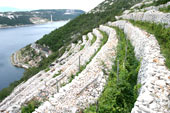 A
unique and surprising combination of the Mediterranean and Alpine
influences on Kvarner, as nowhere else in Croatia, has resulted in a
vivid ethnological and anthropological diversity. The islands, the
shores and the highlands of Kvarner mutually permeate, creating an
utterly distinctive cultural symbiosis. This area has always been an
‘arena of the strong and a refuge of the weak’, at times when
authorities were changing, state borders being demarcated or populations
migrating. Life used to follow its own routine here, paying more or less
attention to these changes, protecting its autonomy, as is so often the
case in the Mediterranean milieu. This is the prerequisite for survival
and the essence of the mentality. The Gorski kotar region, Kvarner’s
mountainous continental hinterland, so different from the coast, closes
the circle and makes this area utterly unique. A
unique and surprising combination of the Mediterranean and Alpine
influences on Kvarner, as nowhere else in Croatia, has resulted in a
vivid ethnological and anthropological diversity. The islands, the
shores and the highlands of Kvarner mutually permeate, creating an
utterly distinctive cultural symbiosis. This area has always been an
‘arena of the strong and a refuge of the weak’, at times when
authorities were changing, state borders being demarcated or populations
migrating. Life used to follow its own routine here, paying more or less
attention to these changes, protecting its autonomy, as is so often the
case in the Mediterranean milieu. This is the prerequisite for survival
and the essence of the mentality. The Gorski kotar region, Kvarner’s
mountainous continental hinterland, so different from the coast, closes
the circle and makes this area utterly unique. On the barely accessible, sparsely vegetated rocky landscape, where only astringent, bitter herbs grow, the will to survive becomes even stronger and more stubborn. Everyday life was painstaking and spiced with rare, small pleasures. Natural conditions and administrative-political changes would condition life on weekdays and feast days. The human existence was based on agriculture, the painstaking cultivation of small arable bits of karst land that were literally reclaimed from the stony environment. Generations would dig stones out of the soil and pile them up to form small terrace-like areas of arable land on steep slopes descending to the sea. If necessary, earth would be hauled there in bags over the shoulder and surplus stones would be piled up in heaps. Everything else that was needed for the household and the land would also be carried in, mainly by hand or by back. Typical Mediterranean crops used to be grown here: olives, vines, vegetables, fruits, and in Gorski kotar, potatoes and cabbage. As an additional source of nourishment, people used to collect wild plants and fruits - an activity that has remained very popular up to the present day. Everything had to be fully used in order to survive. Cattle breeding was not very developed – people bred mainly poultry and smaller livestock. The settlements along the coast and on the islands comprised closely packed stone houses, narrow lanes and passages. The origin of these settlements has to do with the abundance of stone as a building material and the configuration of the rocky karst land. The settlements were raised on dominant hilltop locations with good views of the surrounding area, for reasons of control and defence. The sea is a gateway that is easily accessible and always open to everybody, therefore most ancient settlements arose at a safe distance from it; only the recent, tourist resorts were built along the coastline. Houses were typically made of stone, with a gable roof. The entrance to the living space was from a terrace, locally called the baladur, which was reached by a set of steps. Below the terrace was the entrance to the cellar (konoba) under a semi-circular vaulted passage (volta). People from the seaside villages used to make their living by fishing and seafaring. Fishing was and still is a major economic activity, since fish was used as food, for trade or for exchange. Fishing equipment and techniques have remained basically unchanged up to the present day - what has evolved are the materials from which fishing tools are made (in the past, wicker for fish traps and cotton thread for fishing nets and fishing lines), and the fuel (in the past, spruce wood for lights to lure the fish, the power of the wind and one’s own hands). Some fishing techniques are not used anymore, like the seine nets that would be pulled out to the shore, or the fixed nets for tuna fishing. Fishing and seafaring meant the almost constant absence of men from the villages. Only the worn out old men, the boys and women of all generations would stay behind, giving each place an atmosphere of expectation, wistfulness and yearning; the image of women dressed in mourning comes easily to mind. Voyages could last for three years or longer; no one could say for certain who was alive and who would return. Men would sail off to America or Australia because the barren land back home could never yield enough to survive. They would not return for years, and some of them stayed away forever. Their letters would be awaited for days, even for months. People and ships would come and go. Parting and homesickness were indispensable facts of life, a part of everyday living. The relationship between man, environment and tradition, as well as the exchanging of other cultural goods, objects and knowledge that seafarers and emigrants would bring with them in their luggage resulted in a unique cultural heritage. Its material remnants are but reminders for further research, the basis on which to reconstruct the social and spiritual components that make up life as a whole. Finest china from Marseilles, the coconuts and cashew nuts given to children on St. Nicholas’s Day, the water jar called jarra of north African origin that could be found in many houses, folk costumes from the island of Susak made of denim - all these items would be used in the same household alongside many other typical items made by local craftsmen. The thoughts about survival may have been sorrowful, the way to earn a living may have been more difficult, but generally, life was more cheerful. Parlour games were an essential leisure activity and entertainment on evenings and Sundays. It should be said that only men used to meet in the pub, locally called the oštarija (dopolavoro during the Italian administration), or on the main square in the centre of village (the placa), to play cards or boccia (games that are also popular today), or to exchange stories and jokes, shout and curse. The women used to stay at home and chat. The linguistic heritage of the Čakavian dialect is very vivid indeed, because the old customs and the identity have survived right up to the present day – and these are exactly the components that make up such a special and distinguished ethnos. The carnival tradition has taken deep roots here on Kvarner. This winter merrymaking with the practical purpose of catharsis or cleansing is celebrated at the end of the old and the beginning of the new vegetation period. It should beckon fertility, comfort the superstition and call for a new and better world order. It is a celebration of life itself and a pledge for a better future. The carnival begins after the Epiphany or on the feast day of St. Anthony on 17th January, and lasts until the beginning of the 40-day period of Lent before Easter. The origin of the carnival tradition goes back to pagan and antique customs that were modified in the spirit of Christianity and which have remained preserved up to the present day as a very vivid tradition on Kvarner, especially in the Kastav area. Some archaic forms that used to be important elements of ancient rituals are still present today. The whole carnival takes place in a very special part of the year when old nature dies and new nature is born, which is very important in terms of rituals and superstition. Our present carnival has much to do with antique rituals like the Saturnalia, the Lupercalia, the Matronalia, etc. The carnival is a period for letting go of accumulated fears; it is the beginning of a new, benevolent and fruitful life cycle, free of evil spirits. Ethnological collections have much to teach us about everyday life on Kvarner in the past. On the coast and on the islands, such collections are open to visitors in Kastav, Mošćenice, Grobnik, Dobrinj, Port, Baška, Lopar, Osor, Beli, Bakar, Novi Vinodolski, and on the small island of Košljun. Gorski kotar includes collections in Prezid, Lič and Čabar. The area of Brod Moravice hosts the ethnic village of Šimatovo. 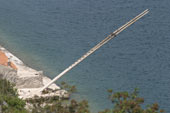 Tunere
are shore-based tuna lookouts that were erected to assist one of the
main activities of Kvarner’s fishermen – tuna fishing. Due to the mainly
inaccessible shore and the small number of coves, fixed nets were used
to catch tunas. At places where tuna shoals would pass, people built
tunere, lookout posts for spotting shoals that were reached by ladders
reaching out over the sea. Such lookouts were located in Preluk, in the
bay of Bakar, in several places on the island of Krk and elsewhere. Tuna
fishing in Preluk was first mentioned as early as 1438 when the Rijeka
authorities allowed fishermen from Rijeka and Kastav to build their tuna
fishing posts. In the mid-17th century, Jesuits from Rijeka were given
the right to catch tuna in Preluk. It was probably then that three
lookout posts with ladders were raised. The owners of many tuna fishing
posts on Kvarner, including some in Bakar, were in the 16th and 17th
century the Zrinski and Frankopani dukes. The sea here was first
exploited by their fishermen, but later they would lease it because that
way they could earn more than by milling, wine producing or fishing. Two
lookout posts with ladders have recently been restored near Bakarac. Tunere
are shore-based tuna lookouts that were erected to assist one of the
main activities of Kvarner’s fishermen – tuna fishing. Due to the mainly
inaccessible shore and the small number of coves, fixed nets were used
to catch tunas. At places where tuna shoals would pass, people built
tunere, lookout posts for spotting shoals that were reached by ladders
reaching out over the sea. Such lookouts were located in Preluk, in the
bay of Bakar, in several places on the island of Krk and elsewhere. Tuna
fishing in Preluk was first mentioned as early as 1438 when the Rijeka
authorities allowed fishermen from Rijeka and Kastav to build their tuna
fishing posts. In the mid-17th century, Jesuits from Rijeka were given
the right to catch tuna in Preluk. It was probably then that three
lookout posts with ladders were raised. The owners of many tuna fishing
posts on Kvarner, including some in Bakar, were in the 16th and 17th
century the Zrinski and Frankopani dukes. The sea here was first
exploited by their fishermen, but later they would lease it because that
way they could earn more than by milling, wine producing or fishing. Two
lookout posts with ladders have recently been restored near Bakarac.Porat (port) is a sheltered mooring for boats and ships with a long waterfront, suitable for ships that regularly connect the islands with the mainland. Larger ports have a harbourmaster’s office. On the islands, the term port refers to any smaller harbour that is the gateway to the island, the place where the most important daily event takes place - the arrival of the ship that provides the island’s only connection with the mainland. The port is the heart of every seaside resort, usually the central meeting place for fishermen, boat owners, children, old men, sailing enthusiasts or passers-by. This is where the fishing nets are mended, fish unloaded or sold, boots repaired, where children play or learn to row, sail, and dive. In the port you will always find someone who knows about the sea and fishing, the local weather or about the dangers that bad weather can bring. 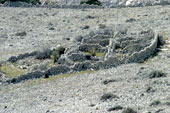 Gromača
is a dry-stone wall constructed without binder, typical of the whole
Mediterranean area. In order to create more fertile soil, stones were
dug out of the earth and piled up, creating terrace-like areas on the
slopes. Reclaiming earth from the stony soil and making it fertile was a
hard job. Gromače also marked the boundaries of individual plots of
land. Stones that were dug out but could not be used for walls would be
piled up onto a heap. Typical examples are the sloping dry-stone walls
in the bay of Bakar: the inaccessible, steep stony slopes between Bakar
and Bakarac were almost entirely cultivated like this. People began to
cultivate land in this way probably in the 18th century and continued to
do so until the 1930s. These areas were mostly used to grow vines – here
in the bakar region a special sort, the belina, from which the famous
dry sparkling Bakarska vodica wine was made. Today these walls are being
restored and the belina is being cultivated once again. On the island of
Krk are some examples of the circular-shaped dry-stone constructions
called mrgari. They are built in the countryside, outside urban areas,
and used as sheepfolds. Gromača
is a dry-stone wall constructed without binder, typical of the whole
Mediterranean area. In order to create more fertile soil, stones were
dug out of the earth and piled up, creating terrace-like areas on the
slopes. Reclaiming earth from the stony soil and making it fertile was a
hard job. Gromače also marked the boundaries of individual plots of
land. Stones that were dug out but could not be used for walls would be
piled up onto a heap. Typical examples are the sloping dry-stone walls
in the bay of Bakar: the inaccessible, steep stony slopes between Bakar
and Bakarac were almost entirely cultivated like this. People began to
cultivate land in this way probably in the 18th century and continued to
do so until the 1930s. These areas were mostly used to grow vines – here
in the bakar region a special sort, the belina, from which the famous
dry sparkling Bakarska vodica wine was made. Today these walls are being
restored and the belina is being cultivated once again. On the island of
Krk are some examples of the circular-shaped dry-stone constructions
called mrgari. They are built in the countryside, outside urban areas,
and used as sheepfolds.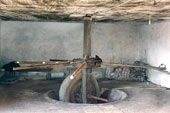 The
Toš
has played an indispensable part in the story of olive cultivation, an
important Mediterranean crop whose oil has extraordinary nutritional
value and is highly praised. On Kvarner several sorts of olive are grown
(known locally as drobnice, oblice, utorkuli), some being more
appropriate for pressing oil, others for consumption. The oil used to be
extracted in a primitive way at home, or using an olive mill, locally
called a toš. A toš consists of a circular stone base on which a heavy
stone wheel rotates to press the olives and extract the oil. The
squeezed mass would then be put into circular knitted sacks, locally
called the športi, and then pressed again to extract the last drop of
oil from it. How the olives are milled, the rights and duties of the
owners of the toš and the olive trees and the authorities were all
regulated by a system of common law. The
Toš
has played an indispensable part in the story of olive cultivation, an
important Mediterranean crop whose oil has extraordinary nutritional
value and is highly praised. On Kvarner several sorts of olive are grown
(known locally as drobnice, oblice, utorkuli), some being more
appropriate for pressing oil, others for consumption. The oil used to be
extracted in a primitive way at home, or using an olive mill, locally
called a toš. A toš consists of a circular stone base on which a heavy
stone wheel rotates to press the olives and extract the oil. The
squeezed mass would then be put into circular knitted sacks, locally
called the športi, and then pressed again to extract the last drop of
oil from it. How the olives are milled, the rights and duties of the
owners of the toš and the olive trees and the authorities were all
regulated by a system of common law.The oil used to be kept in stone vessels of different sizes. Preserved examples of toš can be seen in Mošćenice, Brseč, Veli Lošinj, Ćunski Valun, Porat, Punat (from the 1770s, the oldest toš on the island of Krk) and some other places. 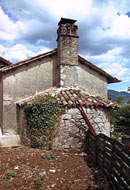 The Tornica
is a typical rural element of architecture on Kvarner. In the villages
of the Liburnian hinterland, characterised by scattered houses and
architecture folding neatly into the surrounding landscape, a typical
family home consisted of a cellar (konoba), a kitchen with a tornica,
one or two rooms (kamare), and a loft (šufit). The courtyard was usually
paved with flagstones and had a well (šterna) for collecting rainwater,
a smaller sheep pen (dvor), and a cellar for dry branches and leaves
(venjak). The tornica is a semi-circular extension of the kitchen with a
fireplace (ognjišće) and a hood or chimney. The fireplace was the
central area of the household; this is where people would eat together,
and it was also the heated living area in wintertime. The fireplace and
the hearth were equipped with poker and other tools for stirring up the
fire, tripods for cooking pots, and an iron chain on which the
indispensable kettle for cooking polenta, heating up water, etc. would
be hung. There was also a grate for grilling fish, earthenware dishes,
pots, specific lids called čripnja or peke for baking bread or potatoes,
jars for wine and water called bukaleta. Sometimes a tornica also
included a bread oven (peknjica). The Tornica
is a typical rural element of architecture on Kvarner. In the villages
of the Liburnian hinterland, characterised by scattered houses and
architecture folding neatly into the surrounding landscape, a typical
family home consisted of a cellar (konoba), a kitchen with a tornica,
one or two rooms (kamare), and a loft (šufit). The courtyard was usually
paved with flagstones and had a well (šterna) for collecting rainwater,
a smaller sheep pen (dvor), and a cellar for dry branches and leaves
(venjak). The tornica is a semi-circular extension of the kitchen with a
fireplace (ognjišće) and a hood or chimney. The fireplace was the
central area of the household; this is where people would eat together,
and it was also the heated living area in wintertime. The fireplace and
the hearth were equipped with poker and other tools for stirring up the
fire, tripods for cooking pots, and an iron chain on which the
indispensable kettle for cooking polenta, heating up water, etc. would
be hung. There was also a grate for grilling fish, earthenware dishes,
pots, specific lids called čripnja or peke for baking bread or potatoes,
jars for wine and water called bukaleta. Sometimes a tornica also
included a bread oven (peknjica).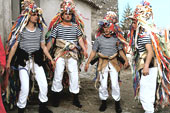 Zvončari,
the bell-ringers, are followers of the ancient magical tradition of
Lupercalia, pastoral rituals in which men would dress up in animal skins
to protect their herds. They are typical of the areas of Rukavac,
Halubje, Mune, Zvoneće, Brgud, etc. They are mutually distinguished by
the character of their masks that can be either zoomorphic (animal
masks) or vegetable (caps with flowers, the so-called krabujosnice).
Other details may also vary: their striped sailors’ T-shirts or checked
shirts, red or vividly coloured scarves, wooden sticks with grotesque
heads which they swing in ritualistic motion, the size of the bell and
the way it is rung. Each group has its own rules and moves in a
particular ritualistic way, accompanied by the traditional figures of
the bear, devil, flag carrier, musician, etc. Zvončari are men of all
generations – particular importance is given to passing the tradition on
to each new generation. During their procession, which is accompanied by
the deafening sound of bells, the zvončari sometimes form a specific
circular shape, the so-called zvončarsko kolo. Zvončari from Žejane
carry a coat made of ribbons in different colours and several smaller
bells that jingle rather than produce heavy noise. They also move
completely differently and hop in small steps. Other traditional groups
come from the areas of Kastav and Grobnik (dondolaši). Zvončari,
the bell-ringers, are followers of the ancient magical tradition of
Lupercalia, pastoral rituals in which men would dress up in animal skins
to protect their herds. They are typical of the areas of Rukavac,
Halubje, Mune, Zvoneće, Brgud, etc. They are mutually distinguished by
the character of their masks that can be either zoomorphic (animal
masks) or vegetable (caps with flowers, the so-called krabujosnice).
Other details may also vary: their striped sailors’ T-shirts or checked
shirts, red or vividly coloured scarves, wooden sticks with grotesque
heads which they swing in ritualistic motion, the size of the bell and
the way it is rung. Each group has its own rules and moves in a
particular ritualistic way, accompanied by the traditional figures of
the bear, devil, flag carrier, musician, etc. Zvončari are men of all
generations – particular importance is given to passing the tradition on
to each new generation. During their procession, which is accompanied by
the deafening sound of bells, the zvončari sometimes form a specific
circular shape, the so-called zvončarsko kolo. Zvončari from Žejane
carry a coat made of ribbons in different colours and several smaller
bells that jingle rather than produce heavy noise. They also move
completely differently and hop in small steps. Other traditional groups
come from the areas of Kastav and Grobnik (dondolaši). Društvene igre are part of the tradition in the coastal areas. They are the popular leisure activity and entertainment for men and children on Sundays and feast days (recently also for women, but this is more an exception than a rule). Popular games include boccie, cards (briškula and trešete) and mőra. Children used to play Nine Men’s Morris, marbles and games connected with some specific feast, for example at Easter. The court for playing boccie is an essential part of every settlement; it is usually located in the centre and serves as a daily meeting place. Boccie is a kind of lawn bowling in which two groups of players try to roll wooden or metal balls at a jack. Sometimes they have to knock out a competitor’s ball with a direct hit, which is a rather impressive achievement. The card games briškula and trešeta are played in pairs with Italian cards, the popular Triestine Cards. Mőra is played by two players: each player shows a number by the fingers of one hand and shouts out a number which should be the sum of all displayed fingers. This is accompanied by rhythmical hitting of the wooden table. Children used to play Nine Men’s Morris, so even today we still find boards for this game cut into stone, for example in Mošćenice. The Folk costumes that people wear on Kvarner are very heterogeneous and were created under various cultural influences. Every region or island has its own distinctive features: the costumes differ from place to place in their detail, the way they are worn, adornments, etc. This diversity that cannot be explained by a simple definition is the most valuable heritage of Kvarner’s folk costumes. Let us mention some of the curiosities. The costume of the women from Krk consists of a white blouse with wide, folded sleeves and a heavy, mostly black or red, folded skirt. The kotiga is a very special winter skirt made of sheep’s fleece that provides excellent protection from the cold bura wind. The headgear is called a rub or dubljenac. This is a wide woven ribbon, mainly of a yellow colour, that is wound around the head in different ways, like a turban. Men wear a kaban – a heavy coat made of linen to protect from the cold. Particularly vivid are the costumes from some of the other islands, like the islands of Susak and Cres. The costume from Orlec is finely embellished with corals and a necklace made of a row of medals and coins with a small box – a reliquary. The Crossbowmen from Rab are the main protagonists of a knights’ tournament that was first established in 1364 to commemorate the defence of the town of Rab by crossbows, a weapon that goes back to ancient times. These medieval games were revived in 1995 and now take place in Rab every year. Crossbows are also used by the balestrieri from San Marino. The tournament lasts for several days and begins with the arrival of the duke and his entourage into the town’s loggia where crossbowmen and flag carriers are gathered. They then receive a blessing in the cathedral, to the sound of drums, fanfares and ringing church bells. This is followed by the opening ceremony on the square in front of the church and the raising of the town flag. On the sign of the honoured judge, twelve knights start the tournament. The winner is declared by the duke of Rab and awarded the Felix prize. The event continues with music, a display of old trades and historical costumes. The tournament takes place twice a year, at the end of May and the end of July. The Feast of the Assumption of the Blessed Virgin Mary on the 15th of August is also celebrated in a medieval spirit. Gumno is a raised walled circular stone area, reached by a short flight of steps, which served for manual corn threshing. Such places are characteristic of the island of Krk because that is where most of Kvarner’s corn is grown, despite its karst soil. Sheaves are placed on the ground and then beaten with special implements to separate the corn kernels from the ears. The corn is then winnowed to separate the wheat from the chaff, and after that it is sifted. Gumnos used also be social meeting places where young people would come together to sing and dance on summer evenings. The gastronomy of the coastal area is humble and simple, typically Mediterranean, based on fish and vegetables but not many cereals because the small areas of arable land are not suitable for growing them in large amounts. Fish is prepared in a simple way – boiled with the addition of olive oil, or in a stew called a brodet. Popular are the various dishes eaten with a spoon, such as maneštra vegetable soup, and other simple traditional dishes like polenta (maize porridge), cabbage, turnip, beans, barley, and goulash with pasta or potatoes. People used to eat five times a day, just as is recommended by the experts today. The most popular vegetables were Swiss chard, radicchio, kohlrabi; also beans and peas. Meat was prepared on feast days, and codfish in times of fasting. More high-calorie dishes were cooked when the most demanding work had to be done. Common spices and additions to dishes include parsley, onion, garlic, celery, and carrot. Wine is drunk daily and is considered part of a diet. Scampi and wild-grown asparagus are highly appreciated specialities. In Gorski kotar people gather mushrooms and fruits of the forest. Other specialities of the area include game dishes and a special stuffing made of bread, meat and eggs. The island of Krk is also home to a particular kind of pasta – šurlice. Kvarner’s sweet pastries include fritule fritters, smokvenjak fig cake and the famous Rab cake. Marunada (Chestnut Days) is a gastronomic festival that takes place in Lovran, a town that has always been famous for its sweet fruits: figs, grapes, olives, cherries, wild plants and of course sweet chestnuts, locally called the maruni – hence the name of the festival. Their quality was praised by J.W. Valvasor in the 17th century and travel writers and explorers like Dragutin Hirc at the end of the 19th century. The Marunada takes place in the second half of October in Lovran, Dobreč and Liganj. This much-appreciated type of chestnut grows only here on Liburnia, in the area between Ika and Mošćenička Draga. It originates from the northern Greek province of Thessaly. Two ways of categorising the chestnut are distinguished here: the branac falls naturally from the trees and is gathered from the ground, but it doesn’t last long and must be consumed quickly, while the dubenac is shaken from the trees, left lying in heaps for about three weeks, and then taken out from its cupules. Chestnuts treated in this way are highly appreciated and can be preserved until Christmas. The Marunada, the traditional gastronomic chestnut festival since 1973, includes a wide choice of various delicacies made of this rare sweet chestnut. The Craftsmen from Kastav are a part of the tradition of the area around Kastav, a hilltop town located between Rijeka and Opatija. Settled since prehistoric times, Kastav is a typical Mediterranean town with medieval defensive walls, town gate and loggia. It was the seat of the Kastav manorial estate that stretched from River Rječina in the east to the hilltop town of Mošćenice in the west; Volosko was its main sea harbour. Handicrafts and trade, together with agriculture and cattle breeding, have been the basis of the local economy since ancient times. Its products are offered for sale at the Bela nedeja fair that traditionally takes place on the first Sunday in October. In Kastav there was once a school for masons, carpenters, coopers, basket- and kettle-makers. Visitors can learn more about these handicrafts and the traditional way of life of the Kastav region from the Kastav collection of regional items and from the first Croatian cooper museum, also in Kastav, near the site of the oldest known cooperage on Kvarner. 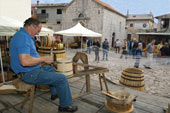 The
Kovačija
(blacksmith’s forge) in Dražice is one of the three forges that once
existed in this part of the Grobnik area, built more than 70 years ago.
The Kovačija belongs to the family that has worked in it for several
generations. Today’s owner inherited it from his grandfather, a
qualified blacksmith. The Kovačija is a museum of forging, featuring
many original items like the anvil, fireplace, bellows, various tools,
etc. The
Kovačija
(blacksmith’s forge) in Dražice is one of the three forges that once
existed in this part of the Grobnik area, built more than 70 years ago.
The Kovačija belongs to the family that has worked in it for several
generations. Today’s owner inherited it from his grandfather, a
qualified blacksmith. The Kovačija is a museum of forging, featuring
many original items like the anvil, fireplace, bellows, various tools,
etc.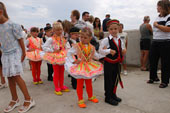 Life on Susak,
a small island with an area of 3.8 km2, has always been determined by
its really unique geology and culture. Susak is made of sand and has
only one settlement, consisting of the older part up on the hill (Gornje
selo) and the more recent part that stretches downhill towards the sea,
locally known as the Spjaza. The roofs of the old dry-stone, one-room
houses used to be made out of the reeds that grow on the island. Newer
houses have a cellar in the basement In the church of St. Nicholas in
the upper part of the village was a wooden crucifix from the 12th
century. Legend tells how the sea threw this cross up on the shore where
it was found by some Benedictines. The locals call it Veli Buoh (Great
God). Until the flourishing of tourism, the main occupations here were
fishing and the production of a renowned wine. Indigenous vines grow
here: sušćan crni, susac, trojišćina, krizol, pleskunaca, martinčića
gruozje. Picturesque, colourful folk costumes consist of a red-patterned
lower skirt, a white underskirt and an upper black skirt gathered into
fine folds. This costume is particularly impressive when the dancers
spin in a lively rhythm. It has its roots in the Hispanic cultural
influence on the Mediterranean in the 16th century, at a time when Susak
was an island of pirates. The present costume is very vivid in colour
and gathered into folds. It was drastically shortened in the period
between the two World Wars under the influence of the French mode from
the 18th century that came here through Venice. Today, Susak is mostly
an island of emigrants, as most of its people now live in Hoboken, New
Jersey. But every year they return to the island to celebrate the Day of
the Emigrants. Life on Susak,
a small island with an area of 3.8 km2, has always been determined by
its really unique geology and culture. Susak is made of sand and has
only one settlement, consisting of the older part up on the hill (Gornje
selo) and the more recent part that stretches downhill towards the sea,
locally known as the Spjaza. The roofs of the old dry-stone, one-room
houses used to be made out of the reeds that grow on the island. Newer
houses have a cellar in the basement In the church of St. Nicholas in
the upper part of the village was a wooden crucifix from the 12th
century. Legend tells how the sea threw this cross up on the shore where
it was found by some Benedictines. The locals call it Veli Buoh (Great
God). Until the flourishing of tourism, the main occupations here were
fishing and the production of a renowned wine. Indigenous vines grow
here: sušćan crni, susac, trojišćina, krizol, pleskunaca, martinčića
gruozje. Picturesque, colourful folk costumes consist of a red-patterned
lower skirt, a white underskirt and an upper black skirt gathered into
fine folds. This costume is particularly impressive when the dancers
spin in a lively rhythm. It has its roots in the Hispanic cultural
influence on the Mediterranean in the 16th century, at a time when Susak
was an island of pirates. The present costume is very vivid in colour
and gathered into folds. It was drastically shortened in the period
between the two World Wars under the influence of the French mode from
the 18th century that came here through Venice. Today, Susak is mostly
an island of emigrants, as most of its people now live in Hoboken, New
Jersey. But every year they return to the island to celebrate the Day of
the Emigrants.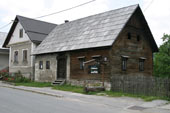 Prezid
is a settlement of interesting origin and intriguing heritage. It was
first mentioned in 1260 as Brezidan and was formed as part of the
Frankopan estate in the 15th and 16th centuries. The seat of the
Frankopan estate was in the region of Vinodol, near the border of the
Western Roman Empire that passed along the ancient wall (limes, or “pri
zidu” in the local dialect – hence the name) which protected the Empire
from barbarians. Prezid is one of the earliest Frankopan settlements in
the Gorski kotar region. Being an open type, it maintained all the
features of a typical Gorski kotar settlement until the second half of
the 20th century. It features preserved old, indigenous wooden houses,
some of them being a valuable part of the ethnological heritage (houses
of the Vesel, Ožbolt, Žagar and Lipovac families). These houses have a
rectangular ground plan and a steep gable roof. Their foundations and
ground floor are built of stone, while the rest is made of wood. The
roof is covered with shingles. The ground floor includes the stable and
the cellar, the residential part is on the first floor, and the loft was
once used for storing hay. Prezid
is a settlement of interesting origin and intriguing heritage. It was
first mentioned in 1260 as Brezidan and was formed as part of the
Frankopan estate in the 15th and 16th centuries. The seat of the
Frankopan estate was in the region of Vinodol, near the border of the
Western Roman Empire that passed along the ancient wall (limes, or “pri
zidu” in the local dialect – hence the name) which protected the Empire
from barbarians. Prezid is one of the earliest Frankopan settlements in
the Gorski kotar region. Being an open type, it maintained all the
features of a typical Gorski kotar settlement until the second half of
the 20th century. It features preserved old, indigenous wooden houses,
some of them being a valuable part of the ethnological heritage (houses
of the Vesel, Ožbolt, Žagar and Lipovac families). These houses have a
rectangular ground plan and a steep gable roof. Their foundations and
ground floor are built of stone, while the rest is made of wood. The
roof is covered with shingles. The ground floor includes the stable and
the cellar, the residential part is on the first floor, and the loft was
once used for storing hay.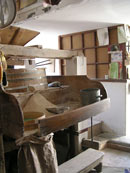 The Watermill in Martinovo Selo,
also called Gaspar’s mill (Gašparov mlin), is one of the 27 mills that
once existed along the River Rječina. Located near the waterfall, it is
still used to mill wheat and corn in the ancient way. Its stone wheel is
driven by the force of the River Rječina. After reconstruction it was
brought into service again in 1992. This is a favourite day excursion
destination for children, because here they can learn about the process
of making flour directly from the miller whose grandfather owned the
mill in the period between 1900 and 1989. Mills once existed throughout
Kvarner – Malinska on the island of Krk got its name after the Croatian
word for mill (“mlin”). The wheat used to be brought there from the
areas of Omišalj and Dobrinj. First there were watermills, then
windmills, and finally engine-powered mills. At the end of the 18th
century there were 12 mills on the island of Krk. The last of them in
the village of Bogovići was closed down in 1976. The Watermill in Martinovo Selo,
also called Gaspar’s mill (Gašparov mlin), is one of the 27 mills that
once existed along the River Rječina. Located near the waterfall, it is
still used to mill wheat and corn in the ancient way. Its stone wheel is
driven by the force of the River Rječina. After reconstruction it was
brought into service again in 1992. This is a favourite day excursion
destination for children, because here they can learn about the process
of making flour directly from the miller whose grandfather owned the
mill in the period between 1900 and 1989. Mills once existed throughout
Kvarner – Malinska on the island of Krk got its name after the Croatian
word for mill (“mlin”). The wheat used to be brought there from the
areas of Omišalj and Dobrinj. First there were watermills, then
windmills, and finally engine-powered mills. At the end of the 18th
century there were 12 mills on the island of Krk. The last of them in
the village of Bogovići was closed down in 1976.The Ganak is the most typical part of houses in the Gorski kotar region, whose foundations and part of the ground floor are built of stone, with the upper part being made of wood. The steep gable roofs are covered with shingles and constructed in a way to protect the façade from precipitation, especially snow. If a house has more than one floor, then the ground floor is usually used as a stable, and the residential part is above it. A narrow stairway leads to the balcony and the entrance to the residential part of the house. This stairway is called a ganak and is usually decorated with potted plants that women in Gorski kotar look after with so much care. 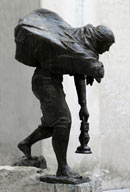 The Mlikarice from the Grobnik
area were milkmaids who would bring freshly produced milk every day
to Rijeka. They would stay up at night to stoke the fireplaces in the
villages of the Grobničko polje (the Field of Grobnik), which at that
time was an agricultural and cattle-raising area. Then they would make
coffee for the other members of the household who were still asleep,
prepare everything the children needed for school, milk the cows in the
stable, load the heavy milk churns onto their backs and then head
downhill to Rijeka. Before the town was connected with the rural
hinterland by bus, the milkmaids would walk for 15 kilometres in one
direction, with this heavy burden. Besides milk, they also used to carry
firewood and sell it in the town. And then they would go the same way
back up the hill again. The “Milky Way” that for centuries poured down
from the pastures in the Grobnik area to Rijeka on the heavily loaded
backs of fragile women dried up forever at the end of the 1990s when the
last mlikarice, at times a part of everyday life in the town and walking
symbols of the connection between the town and its rural hinterland,
disappeared and became only a part of the memory. However, there is one
place in the town where you can still meet a mlikarica: in the square
dedicated to the milkmaids and appropriately called Mljekarski trg, a
statue of a mlikarica from Grobnik created by the sculptor Belizar
Bahorić will never stop her busy walk. The Mlikarice from the Grobnik
area were milkmaids who would bring freshly produced milk every day
to Rijeka. They would stay up at night to stoke the fireplaces in the
villages of the Grobničko polje (the Field of Grobnik), which at that
time was an agricultural and cattle-raising area. Then they would make
coffee for the other members of the household who were still asleep,
prepare everything the children needed for school, milk the cows in the
stable, load the heavy milk churns onto their backs and then head
downhill to Rijeka. Before the town was connected with the rural
hinterland by bus, the milkmaids would walk for 15 kilometres in one
direction, with this heavy burden. Besides milk, they also used to carry
firewood and sell it in the town. And then they would go the same way
back up the hill again. The “Milky Way” that for centuries poured down
from the pastures in the Grobnik area to Rijeka on the heavily loaded
backs of fragile women dried up forever at the end of the 1990s when the
last mlikarice, at times a part of everyday life in the town and walking
symbols of the connection between the town and its rural hinterland,
disappeared and became only a part of the memory. However, there is one
place in the town where you can still meet a mlikarica: in the square
dedicated to the milkmaids and appropriately called Mljekarski trg, a
statue of a mlikarica from Grobnik created by the sculptor Belizar
Bahorić will never stop her busy walk.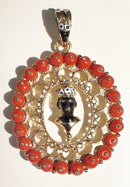 Morčići,
mori, moretti, or morči are the names used to describe the dark-skinned
figure of a Moor, the Arab who became a well-loved motif for jewellery
in the Kvarner area. This figure is particularly symbolic of the town of
Rijeka, but it is also worn along the coast on the islands and, to a
lesser extent, in the Gorski kotar region. A Morčić was at first part of
a humble woman’s dowry, a piece of simple folk jewellery, but later it
became more widely used. The origin of this piece of jewellery in Rijeka
is explained by a legend about the fight between the Croatian noblemen
the Zrinskis and the Turks in the filed of Grobničko polje and the
answered prayers of the women of Rijeka that stones should fall from the
sky and bury the enemy. But it is more likely that this black-skinned
figure is of Venetian origin. The height of its appeal as a luxury item
came in the 18th century when Morčići were brought by sea and other
trading routes to Rijeka. The figure was made of enamel gold adorned
with rubies, pearls and corals. On Kvarner a Morčić is mostly worn as
earrings, while in the Venetian version this figure is mostly found on
brooches and needles. The earring was sometimes worn by men, especially
seafarers, who would carry it with them so they could pay their way back
home in case of shipwreck Morčići,
mori, moretti, or morči are the names used to describe the dark-skinned
figure of a Moor, the Arab who became a well-loved motif for jewellery
in the Kvarner area. This figure is particularly symbolic of the town of
Rijeka, but it is also worn along the coast on the islands and, to a
lesser extent, in the Gorski kotar region. A Morčić was at first part of
a humble woman’s dowry, a piece of simple folk jewellery, but later it
became more widely used. The origin of this piece of jewellery in Rijeka
is explained by a legend about the fight between the Croatian noblemen
the Zrinskis and the Turks in the filed of Grobničko polje and the
answered prayers of the women of Rijeka that stones should fall from the
sky and bury the enemy. But it is more likely that this black-skinned
figure is of Venetian origin. The height of its appeal as a luxury item
came in the 18th century when Morčići were brought by sea and other
trading routes to Rijeka. The figure was made of enamel gold adorned
with rubies, pearls and corals. On Kvarner a Morčić is mostly worn as
earrings, while in the Venetian version this figure is mostly found on
brooches and needles. The earring was sometimes worn by men, especially
seafarers, who would carry it with them so they could pay their way back
home in case of shipwreckThe Ethnographic Collection of the History and Maritime Museum in Rijeka includes items typical for the activities that are the basis of human existence. These are agriculture, cattle breeding, fishing, olive and vine growing. In addition, here you can see items associated with the various means of transport (necessary because of the configuration of the terrain), as well as handicraft products (woodworking, wickerware, cooperage, kettles, pottery, weaving). The exhibition includes a model of a typical settlement with houses and farm buildings, typical kitchenware that people would use on the fireplace (ognjišće) and around it, as well as folk costumes that represent the cultural diversity of the region. The photographs on display show these items in use, that is, the way they were used in everyday life. The Ethnographic Collection in the Košljun Benedictine monastery includes the reconstruction of a typical kitchen in a house on the island of Krk and a loom, locally known as a krosno, on which people from Krk would manually weave their woollen clothes and blankets. Unique old clothes for the men and women of Krk were woven from wool or made of leather. Also displayed are scarves and items of jewellery. The collection is a cultural monument. Another ethnological collection on the island of Krk is in the Franciscan monastery in Porat, which includes an olive mill (toš) from 1850. The museum in Baška also hosts an ethnographic collection that includes a folk costume from the local area, antique dishes and kitchenware. |
|
|
|
|||||
 THE KVARNER COUNTY TOURISM OFFICE 51410 Opatija, Nikole Tesle 2, Tel: +385/51/272-988, Fax: +385/51/272-909 http://www.kvarner.hr, E-mail:kvarner@kvarner.hr |
|||||